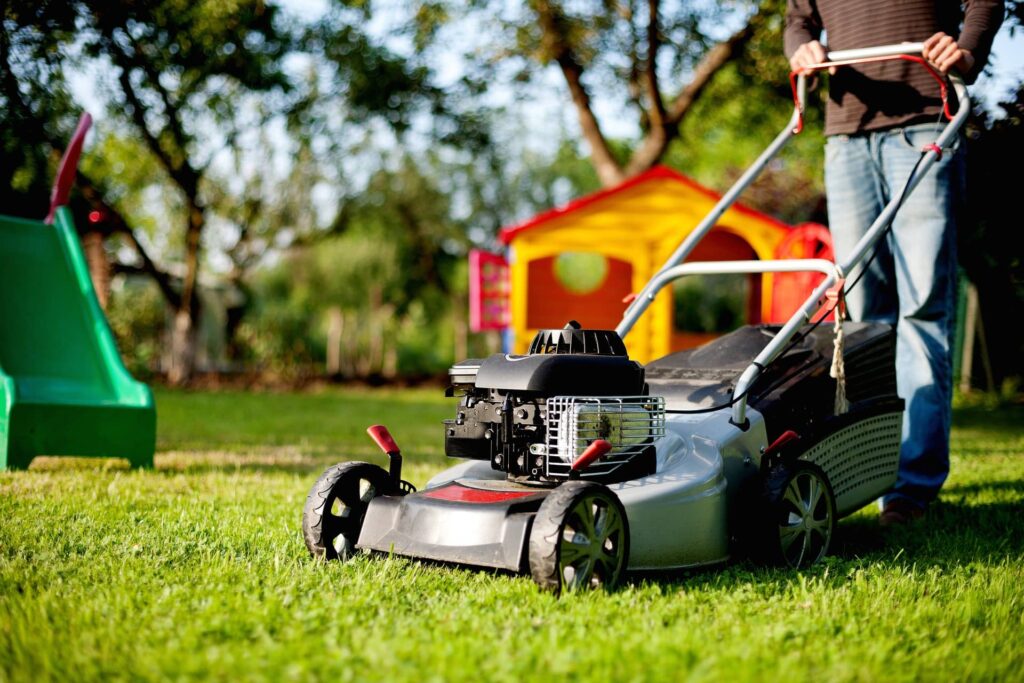A lush, green lawn is more than just a pretty face for your property. It’s a powerhouse of benefits that can transform your lifestyle, boost your health, and even pad your wallet. In this comprehensive guide, we’ll explore the myriad of advantages of a well-maintained lawn and how it can significantly improve your quality of life. From environmental perks to financial gains, get ready to see your lawn in a whole new light.
| Key Takeaways |
|---|
| 1. A well-maintained lawn can increase property value by up to 14%. |
| 2. Lawns act as natural air purifiers, improving local air quality. |
| 3. Regular lawn care activities provide low-impact exercise, burning up to 200 calories per 30 minutes of mowing. |
| 4. Healthy lawns reduce erosion through strong root systems. |
| 5. Turfgrass improves soil health and water quality by filtering pollutants. |
| 6. Lawns can cool surrounding air temperatures by up to 30°F compared to asphalt. |
| 7. Spending time on your lawn can reduce stress and improve mental health. |
| 8. Well-maintained lawns can help reduce allergies by controlling weed growth. |
| 9. A 50×50 foot lawn produces enough oxygen for a family of four for a year. |
| 10. Eco-friendly lawn care practices like using native grasses and organic fertilizers benefit the environment. |
| 11. Smart lawn care technologies are emerging, including robotic mowers and soil sensors. |
| 12. Lawns can foster community interaction and neighborhood pride. |
| 13. Adapting lawn care for climate change includes choosing drought-resistant varieties and improving drainage. |
| 14. Regular maintenance prevents costly repairs and pest infestations. |
| 15. A healthy lawn contributes to noise reduction and creates a quieter living space. |
Introduction: Why Your Lawn Deserves TLC
Imagine stepping out of your home onto a soft, luscious carpet that stretches as far as your property line. This isn’t just a dream – it’s the reality of a well-maintained lawn. But what exactly constitutes a “well-maintained lawn”? It’s more than just mowing regularly. A truly healthy lawn is lush, even in color, free from weeds and bare patches, and resilient to pests and diseases.
The benefits of such a lawn extend far beyond mere aesthetics. As we’ll discover, a healthy lawn can improve your physical and mental health, boost your property value, and even help combat climate change. So, let’s dive into the green world of lawn care and uncover how this often-overlooked aspect of home ownership can revolutionize your lifestyle.
The Aesthetic Appeal: More Than Just Eye Candy

There’s no denying the visual impact of a well-maintained lawn. It’s the first thing people notice about your property, creating that crucial first impression. But the aesthetic benefits of a healthy lawn go beyond mere appearances.
Creating an Outdoor Living Space
A lush lawn transforms your outdoor area into an extension of your home. It becomes a multifunctional space where you can:
- Host barbecues and parties
- Practice yoga or meditation
- Set up a play area for children
- Create an outdoor cinema experience
Pro Tip: To integrate your lawn with other landscaping elements, consider creating defined spaces using hardscaping features like stone pathways or decorative borders.
The psychological effects of a beautiful lawn on homeowners are profound. Studies have shown that spending time in green spaces can reduce stress, improve mood, and increase overall life satisfaction. Your well-maintained lawn becomes a personal oasis, a place to unwind and reconnect with nature.
Moreover, the impact on neighborhood aesthetics can’t be overstated. A street lined with healthy, green lawns creates a sense of community pride and can even lead to improved social connections among neighbors.
Environmental Benefits: Your Lawn as an Eco-Warrior
Contrary to some misconceptions, a well-maintained lawn is a powerful ally in the fight against environmental degradation. Let’s explore how your turfgrass contributes to a healthier planet.
Turfgrass: Nature’s Multitasker
Turfgrass, the foundation of any healthy lawn, is a remarkable plant with numerous environmental benefits:
- Water Quality Improvement: Lawns act as natural filters, trapping pollutants and preventing them from entering waterways.
- Soil Enhancement: Grass roots and thatch improve soil structure, reducing compaction and increasing organic matter.
- Air Cooling: Through evaporation, lawns can significantly cool the surrounding air.
- Air Quality Boost: Turfgrass traps dust and other particulates, improving local air quality.
- Carbon Sequestration: Healthy lawns can capture and store significant amounts of atmospheric carbon.
| Benefit | Description | Impact |
|---|---|---|
| Water Filtration | Lawns trap and filter pollutants | Improved groundwater quality |
| Soil Health | Root systems enhance soil structure | Reduced erosion, better plant growth |
| Temperature Regulation | Evapotranspiration cools air | Lower urban temperatures |
| Air Purification | Grass traps airborne particles | Cleaner local air |
| Carbon Storage | Lawns sequester atmospheric carbon | Reduced greenhouse gas levels |
These environmental benefits showcase how a well-maintained lawn contributes to a healthier ecosystem, making your green space an invaluable part of the urban and rural landscape.
Health and Wellness: Your Personal Green Gym
Your lawn isn’t just good for the environment – it’s great for your health too. Maintaining a healthy lawn provides numerous physical and mental health benefits that can significantly improve your quality of life.
Physical Health Benefits

Regular lawn care activities like mowing, raking, and planting can provide excellent low-impact exercise. These tasks engage multiple muscle groups and can help improve cardiovascular health, flexibility, and strength. It’s been measured that 30 minutes of lawn mowing can burn up to 200 calories!
Mental Health Perks
The mental health benefits of spending time in green spaces are well-documented. Here’s how your lawn can boost your psychological well-being:
- Stress Reduction: The sight and smell of green spaces can lower cortisol levels, reducing stress.
- Improved Mood: Exposure to nature has been linked to increased production of serotonin, a mood-boosting neurotransmitter.
- Enhanced Concentration: Time spent in green spaces can improve focus and attention span.
- Better Sleep: Regular outdoor activity and exposure to natural light can help regulate your circadian rhythm, leading to improved sleep quality.
Allergen Reduction
Contrary to popular belief, a well-maintained lawn can actually help reduce allergies. By keeping your grass short and healthy, you prevent weed growth – a common source of allergenic pollen. Regular mowing also helps control the release of grass pollen.
It has been measured that a 50×50-foot area of turfgrass produces enough oxygen for a family of four to breathe for an entire year!
A Natural Cooling System
One of the most surprising benefits of a healthy lawn is its ability to act as a natural cooling system for your property. This not only makes your outdoor space more comfortable but can also lead to significant energy savings.
How Lawns Regulate Temperature
Lawns cool their surroundings through a process called evapotranspiration. As water evaporates from grass blades, it absorbs heat from the air, effectively lowering the ambient temperature. On a hot summer day, the surface temperature of grass can be 30°F cooler than asphalt and 14°F cooler than bare soil.
Reducing the Urban Heat Island Effect
In urban areas, the cooling effect of lawns becomes even more crucial. Cities tend to be significantly warmer than surrounding rural areas due to the urban heat island effect – a phenomenon caused by heat-absorbing surfaces like concrete and asphalt. Well-maintained lawns help counteract this effect, creating cooler, more comfortable urban environments.
Energy-Saving Benefits
The cooling properties of your lawn can translate into tangible energy savings for your home. By lowering the ambient temperature around your house, a healthy lawn reduces the workload on your air conditioning system. This can lead to lower energy bills, especially during hot summer months.
Pro Tip: To maximize the cooling effect of your lawn, consider planting shade trees strategically around your property. This combination of grass and trees can create a microclimate that significantly reduces your home’s cooling needs.
Financial Advantages: Investing in Green Pays Off

While maintaining a healthy lawn requires some investment, the financial benefits often outweigh the costs in the long run. Let’s explore how a well-kept lawn can be a smart financial decision.
Long-Term Cost Savings
Regular lawn maintenance might seem like an ongoing expense, but it can actually save you money over time. Here’s how:
- Pest Prevention: A healthy lawn is more resistant to pests, reducing the need for expensive treatments.
- Weed Control: Regular mowing and proper care naturally suppress weed growth, minimizing herbicide use.
- Water Conservation: Well-maintained lawns with deep root systems require less frequent watering.
- Erosion Prevention: Strong grass roots prevent soil erosion, saving you from costly landscape repairs.
Impact on Property Value
Perhaps the most significant financial benefit of a well-maintained lawn is its impact on property value. According to a study by the National Association of Realtors, property value can decrease by up to 30% if it is not well-maintained!
| Lawn Condition | Estimated Property Value Increase |
|---|---|
| Poor | 0% |
| Average | 5-10% |
| Excellent | 10-14% |
DIY vs. Professional Services
While professional lawn care services can provide excellent results, many homeowners find that DIY maintenance is more cost-effective. Here’s a quick comparison:
DIY Lawn Care:
- Initial investment in tools and equipment
- Time investment for regular maintenance
- Learning curve for proper techniques
- Lower ongoing costs
Professional Services:
- Higher ongoing costs
- Consistent, professional results
- Time-saving for homeowners
- Access to specialized treatments and equipment
Ultimately, the choice between DIY and professional services depends on your budget, time availability, and personal preferences.
The Social Aspect: Building Community Through Green Spaces
A well-maintained lawn isn’t just a personal asset – it’s a community resource that can foster social connections and neighborhood pride. Let’s explore how your lawn can become a catalyst for community building.
Encouraging Neighborhood Interaction
A beautiful lawn naturally draws people outdoors, increasing the chances of casual interactions with neighbors. These spontaneous meetings can lead to stronger community bonds and a greater sense of belonging.
Ideas for lawn-based community activities:
- Organize a neighborhood picnic
- Host an outdoor movie night
- Set up a community garden corner
- Arrange a lawn game tournament
Hosting Outdoor Events
Your well-maintained lawn provides the perfect backdrop for hosting gatherings, from intimate family barbecues to larger community events. This not only enhances your social life but also positions your home as a hub for neighborhood activities.
Fostering Community Pride
When one homeowner maintains a beautiful lawn, it often inspires others to do the same. This ripple effect can lead to a more attractive, cohesive neighborhood appearance, fostering a sense of community pride and potentially increasing property values across the area.
By maintaining a healthy lawn, you’re not just improving your own property – you’re contributing to the overall well-being and aesthetic appeal of your entire community.
Practical Tips for Maintaining a Healthy Lawn
Now that we’ve explored the numerous benefits of a well-maintained lawn, let’s dive into some practical tips to help you achieve and maintain a healthy lawn.
Essential Tools for Lawn Maintenance
To keep your lawn in top shape, you’ll need a few key tools:
- Lawn Mower: Choose between push, self-propelled, or riding mowers based on your lawn size and budget.
- Edger: For crisp, clean edges along sidewalks and driveways.
- Rake: Essential for removing thatch and leaves.
- Spreader: For even distribution of fertilizer and seeds.
- Sprinkler or Irrigation System: To ensure proper watering.
- Aerator: To reduce soil compaction and improve nutrient absorption.
Seasonal Care Guide
Different seasons require different approaches to lawn care. Here’s a quick overview:
Spring:
- Clean up winter debris
- Apply pre-emergent herbicide to prevent weed growth
- Begin regular mowing as grass starts growing
- Fertilize with a balanced, slow-release fertilizer
Summer:
- Mow regularly, keeping grass at 2.5-3 inches height
- Water deeply but infrequently to encourage deep root growth
- Monitor for pests and diseases
- Spot-treat weeds as needed
Fall:
- Continue mowing until grass stops growing
- Aerate and overseed if necessary
- Apply fall fertilizer to strengthen roots for winter
- Rake leaves to prevent smothering grass
Winter:
- Reduce foot traffic on dormant grass
- Plan and maintain equipment for the coming spring
- Apply winter fertilizer in late fall for cool-season grasses
Common Lawn Problems and Solutions
Even with the best care, lawns can face challenges. Here are some common issues and how to address them:
- Brown Patches:
- Cause: Often due to fungal diseases or grub infestations
- Solution: Improve drainage, adjust watering practices, or apply fungicide if necessary
- Bare Spots:
- Cause: High traffic, poor soil, or pest damage
- Solution: Loosen soil, add compost, and reseed or lay sod
- Weeds:
- Cause: Poor lawn health, over-watering, or under-fertilizing
- Solution: Improve overall lawn health, use targeted herbicides, or remove manually
- Thatch Buildup:
- Cause: Excessive fertilization or poor soil conditions
- Solution: Dethatch with a power rake or vertical mower
Remember, a healthy lawn is the best defense against most common problems. Regular maintenance and proper care will go a long way in preventing these issues.
Eco-Friendly Lawn Care Practices

The history of lawn care has not always been focused on eco-friendly practices. As we become more aware of our environmental impact, it’s crucial to adopt eco-friendly lawn care basics. These methods not only benefit the environment but often result in a healthier, more resilient lawn.
Organic Fertilizers and Pest Control
Chemical fertilizers and pesticides can harm beneficial insects and microorganisms in your soil. Consider these organic alternatives:
- Compost: Rich in nutrients and beneficial microorganisms
- Grass Clippings: Leave them on the lawn as a natural fertilizer
- Neem Oil: A natural pest deterrent
- Beneficial Nematodes: Microscopic worms that prey on harmful insects
Water Conservation Techniques
Efficient water use is key to sustainable lawn care. Try these water-saving strategies:
- Water Deeply but Infrequently: This encourages deep root growth
- Water Early Morning: Reduces evaporation loss
- Use Mulch: Helps retain soil moisture
- Install Rain Barrels: Collect rainwater for lawn irrigation
- Consider Drip Irrigation: More efficient than sprinklers for targeted watering
Choosing Native Grass Species
Native grasses are adapted to your local climate and require less maintenance. They’re often more resistant to local pests and diseases, reducing the need for chemical interventions.
Pro Tip: Research grass species native to your region. Your local extension office can be a great resource for this information.
By implementing these eco-friendly practices, you’ll not only have a beautiful lawn but also contribute to a healthier environment.
The Future of Lawn Maintenance: Trends and Innovations
The world of lawn care is constantly evolving, with new technologies and practices emerging to make maintenance easier, more efficient, and more environmentally friendly. Let’s explore some of the exciting trends shaping the future of lawn care.
Smart Lawn Care Technologies
Technology is revolutionizing how we care for our lawns:
- Smart Sprinkler Systems: These adjust watering schedules based on weather forecasts and soil moisture levels.
- Robotic Lawn Mowers: Like robotic vacuums, these can autonomously mow your lawn.
- Soil Sensors: These devices provide real-time data on soil moisture, pH, and nutrient levels.
- Lawn Care Apps: These offer personalized care schedules and tips based on your specific lawn conditions.
Sustainable Landscaping Practices
Sustainability is becoming increasingly important in lawn care:
- Rain Gardens: These help manage stormwater runoff and support local ecosystems.
- Permeable Pavements: These allow water to seep through, reducing runoff and replenishing groundwater.
- Pollinator-Friendly Lawns: Incorporating flowering plants to support bees and other pollinators.
- Organic Lawn Care: Using natural products and methods to maintain lawn health.
Balancing Traditional Lawns with Eco-Friendly Alternatives
While traditional lawns offer numerous benefits, there’s a growing trend towards more diverse, eco-friendly landscapes:
- Meadow Lawns: Allowing portions of your lawn to grow wild with native grasses and wildflowers.
- Clover Lawns: Clover is low-maintenance, drought-resistant, and fixes nitrogen in the soil.
- Moss Lawns: Perfect for shady areas, moss requires no mowing and little water.
- Synthetic Turf: While not for everyone, high-quality artificial grass can be a low-maintenance option in certain situations.
Adapting to Climate Change
As our climate continues to change, lawn care practices must adapt. Here are some strategies for maintaining a healthy lawn in the face of changing weather patterns:
- Choosing Drought-Resistant Grass Varieties: Species like Bermuda grass, Zoysia, and Buffalo grass are more tolerant of dry conditions.
- Incorporating Xeriscaping Principles: This landscaping approach reduces or eliminates the need for supplemental water from irrigation.
- Preparing Your Lawn for Extreme Weather Events:
- Improve drainage to handle heavy rains
- Use mulch to protect soil during droughts
- Choose hardy grass varieties that can withstand temperature fluctuations
By staying informed about these trends and adapting your lawn care practices accordingly, you can ensure a beautiful, sustainable lawn for years to come.
Conclusion: Embracing the Benefits of a Well-Maintained Lawn
As we’ve explored throughout this guide, a well-maintained lawn offers far more than just aesthetic appeal. It’s a multifaceted asset that contributes to our health, wealth, and the environment. Let’s recap some of the key benefits we’ve discovered:
- Environmental Impact: Your healthy lawn acts as an eco-warrior, improving air and water quality, reducing erosion, and helping to combat climate change through carbon sequestration.
- Health and Wellness: From providing a natural gym for physical activity to boosting mental health and reducing allergens, your lawn plays a crucial role in your overall well-being.
- Financial Advantages: A well-maintained lawn can increase your property value by up to 14% and lead to long-term cost savings through efficient resource use and pest prevention.
- Community Building: Your lawn can become a hub for social interaction, fostering stronger community bonds and neighborhood pride.
- Natural Cooling: Through evapotranspiration, your lawn helps regulate local temperatures, potentially reducing your energy costs.
These benefits underscore the importance of regular, thoughtful lawn care. Whether you’re a seasoned gardener or just starting out, there’s never been a better time to invest in your lawn’s health.
If you are struggling to understand any of the terms in this article, please check out our post on lawn care terminology to clear things up!


